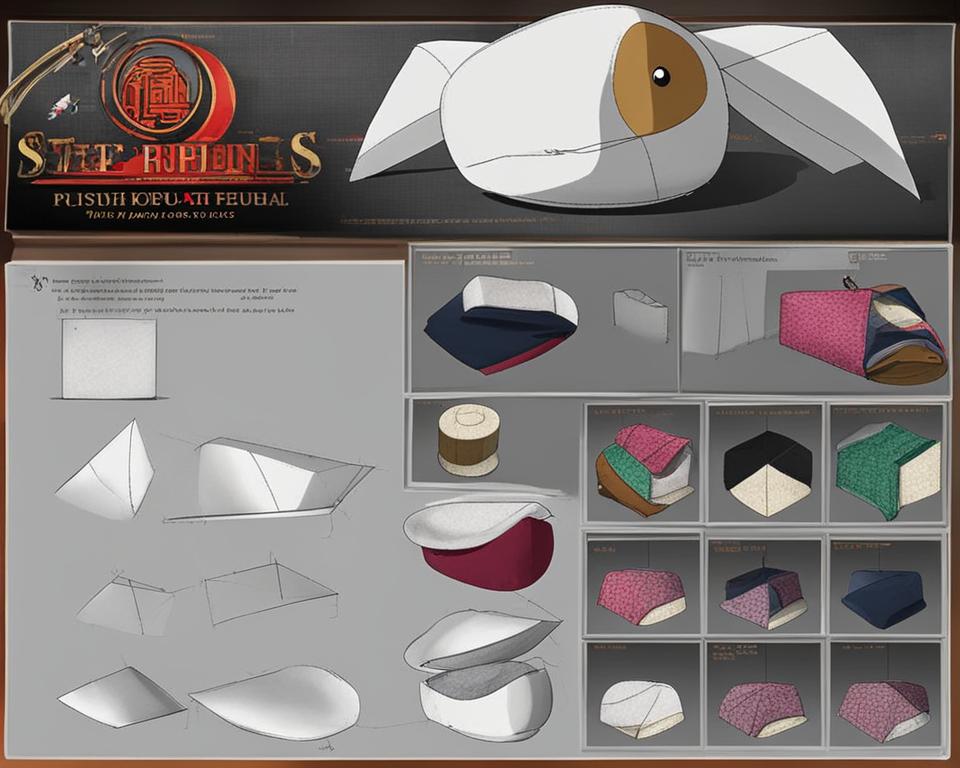Plush toys are not just cuddly companions for children, they also play a crucial role in their social and emotional development. However, these beloved toys can accumulate germs, dust, pollen, and other allergens over time. It is important to regularly clean and disinfect plush toys to keep them safe and hygienic for children. In this section, we will explore effective methods to wash plush toys without causing any damage.
Key Takeaways:
- Regularly cleaning and disinfecting plush toys is important for children’s health and well-being.
- Check the care instructions on the label before machine washing plush toys.
- Hand washing is the best alternative for delicate plush toys that cannot be machine washed.
- Alternative methods like freezing, vacuuming, and baking soda can be used for cleaning stuffed animals.
- Maintain clean plush toys by washing regularly, storing carefully, and spot cleaning stains.
The Best Ways to Machine Wash Plush Toys
Machine washing is one of the best and most efficient methods to clean plush toys without causing any damage. It is important to always check the care instructions on the label of the stuffed animal before proceeding with machine washing. Follow these steps to ensure a safe and effective wash:
- Place the toy inside a mesh laundry bag or pillowcase:
- Use a gentle or delicate cycle with cold water:
- Use a mild detergent:
- Air-dry the toy:
This step is crucial as it helps protect the toy from getting tangled or damaged during the wash cycle.
Using a gentle or delicate cycle ensures that the toy is not subjected to harsh agitation that could potentially ruin its shape or fabric. Cold water is recommended to prevent any color bleeding.
Choose a mild detergent, preferably one that is free and clear of harsh chemicals and fragrances. This will help maintain the softness and integrity of the plush toy.
Avoid using a dryer as the heat can cause plastics parts to melt or damage the toy. Instead, remove the toy from the laundry bag or pillowcase and let it air-dry in a well-ventilated area.
By following these proper washing instructions, you can ensure that your plush toys are thoroughly cleaned while maintaining their quality and longevity.
Table: Comparison of Machine Washing vs. Hand Washing Plush Toys
| Machine Washing | Hand Washing | |
|---|---|---|
| Cleaning Method | Efficient and convenient | Meticulous and time-consuming |
| Suitable for | Most plush toys | Delicate or antique plush toys |
| Water Temperature | Cold water | Warm water |
| Drying | Air-drying | Air-drying in a well-ventilated area |
| Recommended Detergent | Mild detergent | Mild detergent |
How to Hand Wash Delicate Plush Toys
For fragile or antique plush toys that are not suitable for machine washing, hand washing is the best alternative. Cleaning plush toys by hand allows for a gentle and controlled process that minimizes the risk of damage. Follow these steps to hand wash your delicate plush toys:
- Fill a basin or tub with cool water. Add a drop of mild detergent and mix it well.
- Gently place the plush toy in the water. Use a soft cloth or old toothbrush to scrub the toy, focusing on any stains or dirt.
- Rinse off the soap using clean water. Be cautious not to use excessive water, as it can lead to damage.
- Dry the toy with a clean towel, removing as much moisture as possible.
- After towel drying, place the toy in a well-ventilated area to air-dry completely. Avoid using a hair dryer, as the hot air can cause damage.
By following these steps, you can effectively clean your delicate plush toys without compromising their integrity.
Tips for Hand Washing Plush Toys
When hand washing delicate plush toys, it’s important to keep a few additional tips in mind:
- Check the toy’s label for any special care instructions or warnings before proceeding with hand washing.
- Use a gentle touch and avoid excessive scrubbing, as it can cause the toy’s fibers to loosen or tear.
- If the toy has intricate details or embellishments, take extra care when washing around these areas to prevent damage.
- For stubborn stains, create a paste using mild detergent and water. Apply the paste to the stain and gently rub it in before rinsing.
Remember, hand washing is the best method for delicate plush toys that cannot withstand machine washing. Take your time and be gentle to preserve the quality of your cherished toys.
Alternative Methods for Cleaning Stuffed Animals
While machine washing and hand washing are the most common methods for cleaning plush toys, there are alternative methods available for those situations where traditional washing is not possible. These alternative methods can be effective in removing dirt, dust, and germs from stuffed animals without causing damage. Let’s explore some of these alternative methods:
1. Disinfect in the Freezer
One alternative method for cleaning stuffed animals is to disinfect them by placing them in the freezer. Simply place the toy in a plastic bag, seal it, and leave it in the freezer overnight. The low temperatures will help kill germs and bacteria on the toy’s surface. Remember to thoroughly clean the toy afterwards to remove any remaining dirt or debris.
2. Vacuum the Toy
If your plush toy is not suitable for washing, you can use a vacuum cleaner with a brush attachment to remove dust and debris from its surface. Gently run the brush over the toy, paying attention to any seams or crevices where dirt may accumulate. This method is especially useful for larger plush toys or those with delicate features that may not withstand washing.
3. Remove Smells with Baking Soda
If your stuffed animal has an unpleasant odor, you can use baking soda to remove it. Place the toy in a sealable plastic bag and add about a cup of baking soda. Shake the bag for 20-30 seconds to distribute the baking soda evenly, then let the toy sit in the sun for a few hours. Afterward, vacuum the toy to remove any remaining baking soda residue.
Remember, these alternative methods are best suited for surface cleaning and disinfection. If your plush toy is heavily soiled or has stains that cannot be removed with these methods, it may be time to consider a professional cleaning service.
Summary
- Disinfecting stuffed animals in the freezer can help kill germs and bacteria.
- Vacuuming plush toys with a brush attachment can remove dust and debris.
- Baking soda can be used to remove unpleasant odors from stuffed animals.
By using these alternative methods, you can keep your children’s favorite plush toys clean and fresh without the need for machine washing or hand washing.
Tips for Maintaining Clean Plush Toys
Keeping plush toys clean and well-maintained is essential for the health and safety of children. Here are some tips to help you maintain clean plush toys:
- Wash regularly: Make it a habit to wash plush toys when changing and cleaning bed sheets. This will help remove dirt, dust, and allergens that can accumulate over time.
- Store carefully: When not in use, individually wrap stuffed animals in tissue paper before storing them. This will protect them from dust and maintain their shape.
- Spot clean: Occasionally check plush toys for stains and spot clean them as soon as possible. Use a mixture of water and mild detergent to gently scrub away the stains.
- Use stain removal techniques: For tougher stains, create a paste with water and mild detergent. Apply the paste to the stained area and let it sit for a few minutes before gently scrubbing it off.
By following these tips, you can ensure that your child’s favorite plush toys remain clean, fresh, and safe for play. Regular cleaning and proper care will not only keep the toys hygienic but also prolong their lifespan, allowing your child to enjoy them for years to come.

Why Regular Cleaning is Important
Regular cleaning of plush toys is important for several reasons:
- Health and hygiene: Plush toys can harbor germs, dust mites, and allergens that can cause allergies and respiratory problems for children. Regular cleaning helps to remove these contaminants and keep the toys hygienic.
- Longevity: Cleaning plush toys helps to maintain their quality and extend their lifespan. By removing dirt and stains, you can prevent the fabric from becoming worn or discolored over time.
- Peace of mind: Regularly cleaning plush toys provides parents with peace of mind, knowing that their child is playing with clean and safe toys. It also helps to prevent the spread of germs among siblings or playmates.
“Regular cleaning and proper care will not only keep plush toys hygienic but also prolong their lifespan.”
By following these tips, you can ensure that your child’s plush toys remain clean, fresh, and safe for play. Remember to always check the care instructions on the label of the toy before cleaning, and use mild detergent and gentle cleaning methods to avoid damage.
Conclusion
After exploring various methods to wash plush toys, it is clear that regular cleaning and proper maintenance are crucial for keeping these beloved companions safe and hygienic for children. By following the effective washing techniques discussed in this article, parents can ensure that their child’s favorite stuffed animals remain germ-free and in good condition.
Remember to always check the care instructions on the label before machine washing or hand washing plush toys. Using a gentle cycle with cold water and mild detergent will help prevent any damage to the toys. For delicate and antique plush toys, hand washing with a soft cloth or toothbrush is the best option.
In cases where washing is not possible, alternative methods like freezing the toy overnight or vacuuming the surface can help eliminate germs and dust. Additionally, maintaining clean plush toys can be achieved by spot cleaning stains and regularly storing them in tissue paper to protect from dust.
By implementing these plush toy cleaning tips, parents can ensure that their child’s toys are not only clean but also safe for play. So, the next time your child’s favorite stuffed animal needs a wash, refer back to this article and use the appropriate method to keep it fresh and hygienic.
FAQ
Can all plush toys be machine washed?
Before washing, always check the care instructions on the label of the stuffed animal. If it is safe for machine washing, you can follow the steps mentioned in the article.
How do I hand wash delicate plush toys?
Fill a basin or tub with cool water and add a drop of mild detergent. Gently scrub the toy with a soft cloth or old toothbrush to remove any stains or dirt. Rinse off the soap using clean water, and then air-dry the toy in a well-ventilated area.
What if I can’t wash my plush toy in a washing machine or by hand?
In that case, you can try alternative methods such as disinfecting in the freezer, vacuuming the toy, or removing smells with baking soda. Refer to the article for detailed instructions.
How often should plush toys be washed?
It is recommended to wash plush toys regularly, especially when changing and cleaning bed sheets. This helps maintain their cleanliness and hygiene.
How should I store plush toys?
Individually wrap stuffed animals in tissue paper before storing them to protect them from dust and maintain their shape.
How can I spot clean plush toys?
Occasionally check plush toys for stains. Mix water with mild detergent and gently scrub stains with an old toothbrush or cloth. Rinse off the soap and air-dry the toy.
Why is it important to keep plush toys clean?
Regular cleaning and proper care of plush toys are essential for children’s health and well-being. It helps prevent the accumulation of germs, dust, and allergens, ensuring a safe and hygienic play environment.





